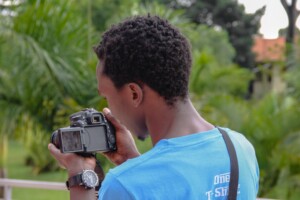Photography
Namibia, the land of diversity and uniqueness, offers a wide selection of the finest photographic opportunities. This land of contrasts and often other-worldly beauty is ideally suited to the professional and amateur alike. Whether the passion is for images of people, nature or landscapes, Namibia has it all and more.
This destination features a wide range of photo subjects, and the superb weather provides excellent light variations. This ensures the visitor can exercise creative styles or record the unique beauty of the land, its inhabitants and its abundant nature. As a result, Namibia is a top-rated destination for photographers.
To capture prized images, our visitors can travel by land or air. The country is ideally suited to both, with good road infrastructure and a selection of aircraft for charter. Some air charter companies operate aircraft with clear windows allowing sharp aerial photography. Vehicles utilized for guided travel feature sliding windows where wildlife may be shy or present a danger.
A selection of suitable rental vehicles is available for independent travel. Itineraries can be tailor-made to include the specific subject interests of the visitor. Options include group or private trips on a guided or independent basis. Africa, the continent of big game, has many game reserves and parks.
The great Etosha National Park is probably one of the best for game numbers, variety, and viewing game throughout the day. The vegetation in most parts is relatively sparse, so Etosha is fantastic for the wildlife photographer. Namibia photographic safaris are designed for keen or professional photographers. Even though any tour or safari to Namibia is, and can be.
Photographic safaris are different to other tours where visitors spend more time in specific areas such as photographing desert and dune landscapes or wildlife in Etosha and Kaokoland. Namibian operators know that a photographer needs more time, has to study the light, and has to find the right site and have a specific interest. Hence the options of guided or self-drive safaris are available from most tour operators. World-class photographic shops are available to assist with technical details or repairs.
When travelling to Namibia, please bear in mind that the country can be warm and dusty. Hence ensure that your camera bags seal effectively, that you bring along cleaning equipment. Also, bear in mind that the sun is very bright, even more in areas like Etosha, where the ground is very whitish, so ensure that adequate UV and polarized filters accompany you on safari.
Tips for Photography in Namibia:
- A good zoom is essential for photographing wildlife.
- Fixed lenses are ultimately better in terms of sharpness, so if you’re aiming to win competitions or blow your pictures up into massive prints, go for a long-fixed telephoto lens, as long as you can carry. Fixed lenses also work best when photographing birds.
- As these lenses can be heavy, you will need to bring a tripod or at least a beanbag, especially handy when travelling by car.
- For landscapes, the best is a short telephoto lens (110 or 135 for 35mm/ 150 for medium format) and wide-angle for certain shots. Please take note that the wide-angle has limitations when it comes to landscapes. It’s better suited for trees, buildings, and other elements that focus on an image.
- If you’re into close-ups, bring a good micro/macro lens rather than close-up filters. Extension tubes, although tedious, also do the job.
- Close-up photography can be very rewarding in Namibia as there are many fascinating insects and small reptiles, incredible textures, plants with intriguing flowers, seeds and leaves, lichen and so on. Even sand grains look great through a macro lens.
- The best time to shoot is early morning or late afternoon when the colours become deep, and the atmosphere glows (early morning light can be bleak). If you’re into sunsets, this is the time to shoot, as there’s a lot of dust hanging around for solid reds and oranges, and silhouettes become spectacular. However, this does not mean that you must never take photographs in the middle of the day. If the scene looks good, take the picture because what you see is what you get. Which, incidentally, means you can take photos of mirages, although they are optical illusions. They are at their most striking in the middle of the day.


